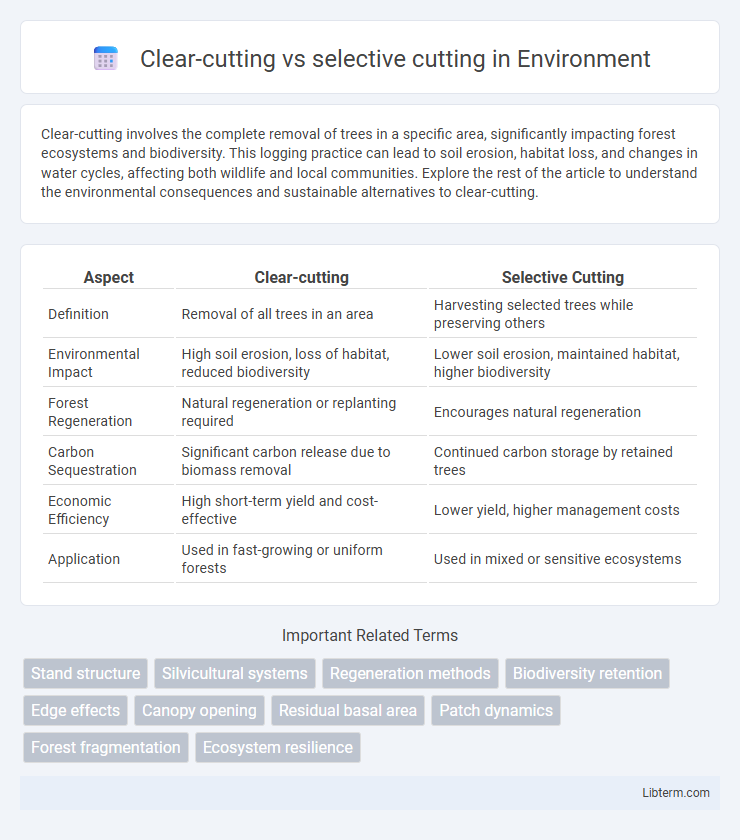Clear-cutting involves the complete removal of trees in a specific area, significantly impacting forest ecosystems and biodiversity. This logging practice can lead to soil erosion, habitat loss, and changes in water cycles, affecting both wildlife and local communities. Explore the rest of the article to understand the environmental consequences and sustainable alternatives to clear-cutting.
Table of Comparison
| Aspect | Clear-cutting | Selective Cutting |
|---|---|---|
| Definition | Removal of all trees in an area | Harvesting selected trees while preserving others |
| Environmental Impact | High soil erosion, loss of habitat, reduced biodiversity | Lower soil erosion, maintained habitat, higher biodiversity |
| Forest Regeneration | Natural regeneration or replanting required | Encourages natural regeneration |
| Carbon Sequestration | Significant carbon release due to biomass removal | Continued carbon storage by retained trees |
| Economic Efficiency | High short-term yield and cost-effective | Lower yield, higher management costs |
| Application | Used in fast-growing or uniform forests | Used in mixed or sensitive ecosystems |
Introduction to Forest Harvesting Methods
Clear-cutting involves removing all trees in a designated area, maximizing timber yield but potentially disrupting ecosystems and soil stability. Selective cutting targets specific trees for removal, promoting forest regeneration and maintaining biodiversity while producing less immediate timber volume. Both methods play crucial roles in sustainable forest management, balancing economic goals with ecological impacts.
What is Clear-Cutting?
Clear-cutting is a forestry practice where most or all trees in a designated area are uniformly harvested, creating an open space that promotes the growth of sun-loving species. This method maximizes timber yield and simplifies reforestation but can lead to significant ecological impacts such as habitat loss, soil erosion, and reduced biodiversity. Clear-cutting is commonly applied in fast-growing conifer plantations or regions prioritizing economic efficiency in timber production.
What is Selective Cutting?
Selective cutting is a sustainable forestry practice that involves carefully choosing and harvesting specific trees based on criteria such as age, size, species, or health, rather than clearing entire areas. This method helps maintain biodiversity, supports wildlife habitats, and reduces soil erosion by preserving the forest's structural complexity. Compared to clear-cutting, selective cutting promotes long-term forest health and ecological balance while still allowing for timber production.
Ecological Impacts of Clear-Cutting
Clear-cutting causes significant ecological disruption by removing entire forest canopies, leading to habitat loss for numerous species and increased soil erosion. This method reduces biodiversity and alters microclimates, often resulting in decreased water quality due to sediment runoff. In contrast, selective cutting preserves forest structure, supporting ecosystem resilience and maintaining biological diversity.
Environmental Benefits of Selective Cutting
Selective cutting promotes biodiversity by preserving a variety of tree species and habitats, supporting wildlife populations and ecosystem resilience. Unlike clear-cutting, which removes all trees in an area and can lead to soil erosion and habitat loss, selective cutting maintains forest structure and nutrients. This sustainable harvesting method aids carbon sequestration by retaining mature trees that absorb more CO2, contributing to climate change mitigation.
Economic Considerations: Clear-Cutting vs Selective Cutting
Clear-cutting offers higher short-term economic returns due to the rapid harvest of timber and lower operational costs, making it attractive for maximizing immediate revenue in commercial forestry. Selective cutting, while more labor-intensive and costly, promotes sustainable forest management by preserving ecosystem services and potentially enhancing long-term timber value through continuous growth. Market demand for sustainably sourced wood and certification programs increasingly influence the economic viability of selective cutting practices.
Effects on Biodiversity and Wildlife
Clear-cutting causes significant habitat loss and fragmentation, drastically reducing biodiversity and displacing wildlife dependent on mature forest ecosystems. Selective cutting preserves structural diversity and maintains habitat continuity, supporting a wider range of species and promoting ecosystem resilience. Studies show that forests managed selectively sustain higher species richness and better wildlife population stability compared to clear-cut areas.
Soil Health and Water Quality Implications
Clear-cutting leads to significant soil erosion and nutrient depletion due to the complete removal of vegetation, which reduces organic matter and microbial activity essential for soil health. In contrast, selective cutting preserves tree cover, maintaining root structures that stabilize soil and enhance water infiltration, thereby reducing sediment runoff and protecting water quality. The retention of canopy in selective cutting also moderates temperature and moisture levels, supporting aquatic ecosystems and minimizing the impact on downstream water bodies.
Sustainable Forestry Practices
Selective cutting preserves forest biodiversity by targeting specific mature trees, promoting natural regeneration and minimizing soil erosion. Clear-cutting, while economically efficient, often disrupts ecosystems and reduces habitat complexity, posing challenges to long-term forest sustainability. Sustainable forestry practices emphasize adaptive management techniques that balance timber production with ecological health, favoring selective cutting to maintain ecosystem services and carbon sequestration.
Choosing the Right Harvesting Method
Choosing the right harvesting method depends on forest management goals, environmental impact, and economic considerations. Clear-cutting efficiently removes all trees in an area, promoting rapid regeneration for species adapted to open sunlight but can lead to soil erosion and habitat loss. Selective cutting targets specific trees, maintaining forest structure and biodiversity while supporting sustainable timber production and reducing ecological disruption.
Clear-cutting Infographic

 libterm.com
libterm.com